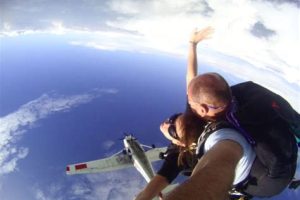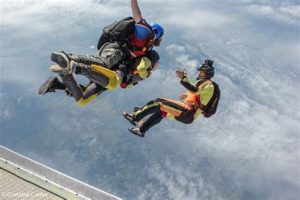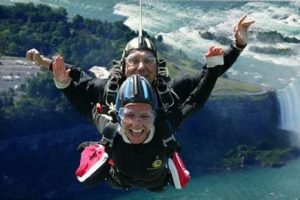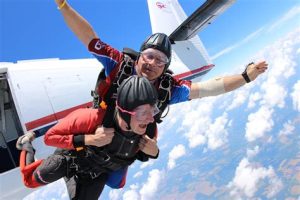Table of Contents
Learn how to skydive solo without the need for a tandem instructor. Our comprehensive guide provides step-by-step instructions on the techniques, equipment, and safety procedures involved in solo skydiving. From choosing the right parachute to mastering freefall techniques, this resource is your ultimate companion to experiencing the thrill of skydiving on your own.
Are you ready to take your skydiving experience to the next level? If you’ve already conquered tandem jumps and are looking for a new challenge, learning how to skydive without a tandem instructor is the ultimate thrill. By following these step-by-step instructions, you’ll be well on your way to experiencing the freedom and adrenaline rush of solo skydiving. So buckle up (or rather, harness up), as we guide you through the process of becoming a confident and independent skydiver. Let’s dive right in!
Introduction
Skydiving is an exhilarating and adrenaline-pumping experience that many people dream of trying. While most beginners start with a tandem jump, where they are strapped to a professional instructor, some daredevils prefer to take the plunge solo from the very beginning. If you’re one of those adventurers seeking the ultimate thrill, here are step-by-step instructions on how to skydive without tandem.
1. Research and Choose a Reputable Skydiving School
Before embarking on this daring adventure, it’s crucial to find a reputable skydiving school that offers solo jumping programs. Look for schools that have experienced instructors, proper equipment, and positive reviews from previous students. Safety should always be your top priority when engaging in extreme sports like skydiving.
2. Complete the Necessary Training
Once you’ve found a suitable skydiving school, schedule your training sessions. These sessions will cover essential topics such as equipment usage, safety protocols, body positioning during freefall, and parachute deployment techniques. The training will also include simulated jumps to help you become familiar with the entire process.
3. Get Familiar with Skydiving Gear
Understanding and using the specialized gear is crucial for a successful solo jump. Familiarize yourself with the skydiving suit, helmet, goggles, altimeter, and most importantly, the parachute system. Learn how to properly wear and adjust each piece of equipment, ensuring that they fit comfortably and securely.
4. Master Proper Body Positioning
A crucial aspect of skydiving is maintaining the correct body position during freefall. The ideal position is to arch your back, with arms and legs slightly bent. This balanced posture helps stabilize your body and control your movements in the air. Practice this position during your training sessions until it becomes second nature.
5. Learn to Control Your Freefall
During your training, you’ll also learn techniques to maneuver your body while in freefall. These maneuvers include turns, forward motion, backward motion, and coordinated movements with other skydivers. Mastering these skills will allow you to enjoy the freedom and thrill of flying through the air during your solo jump.
6. Understand Parachute Deployment
Knowing how to deploy your parachute at the right time is essential for a safe landing. During your training, you’ll learn how to identify the correct altitude for deployment using an altimeter, as well as how to handle any potential malfunctions or emergencies. Remember, safety procedures are of utmost importance when skydiving solo.
7. Prepare Mentally and Physically
Before your first solo jump, take time to mentally prepare yourself. Visualize the entire experience, from exiting the aircraft to landing safely on the ground. Stay focused and confident in your abilities. Additionally, ensure that you are physically fit and well-rested to handle the physical demands of the jump.
8. Choose a Suitable Weather and Location
When planning your first solo jump, consider weather conditions and choose a suitable location. Clear skies, minimal wind, and good visibility are ideal. Discuss the weather forecast with your instructor and follow their guidance to ensure a safe and enjoyable experience.
9. Execute Your First Solo Jump
The moment has arrived! With all your training and preparation, it’s time to take the leap. Board the aircraft, secure your gear, and mentally prepare yourself for the exhilarating experience ahead. Follow the instructions of your instructor, exit the aircraft confidently, maintain proper body position, deploy your parachute at the designated altitude, and enjoy the breathtaking views on your descent.
10. Continue Learning and Progressing
After completing your first solo jump, don’t stop there! Skydiving is an ongoing learning process, and there is always room for improvement. Take advantage of additional training programs, advanced courses, and opportunities to jump in different locations. Embrace the adventure and continue to grow as a skydiver.
Remember, skydiving without tandem requires dedication, discipline, and a thirst for adrenaline. Always prioritize safety, follow instructions carefully, and enjoy the incredible experience of soaring through the sky on your own terms.
Introduction:
Welcome to our guide on how to skydive without tandem! In this step-by-step instructional guide, we will provide you with the necessary information and tips to ensure a safe and exciting solo skydiving experience. Remember to always follow these instructions carefully and consult with a professional instructor if needed.
1. Equipment Preparation:
a. Gather all the required skydiving equipment, including a properly fitted skydiving jumpsuit, helmet, altimeter, and parachute pack.
b. Inspect each piece of equipment thoroughly for any signs of damage or wear and seek professional advice if any concerns arise.
c. Ensure your parachute pack is properly packed and securely fastened before making the jump.
2. Safety Briefing:
a. Attend a comprehensive safety briefing conducted by a certified skydiving instructor.
b. Learn and understand the key procedures, hand signals, emergency protocols, and safety precautions.
c. Clarify any doubts or questions regarding safety procedures before proceeding with the jump.
3. Ground Training:
a. Undergo thorough ground training to familiarize yourself with basic skydiving techniques, body position, and landing procedures.
b. Practice body movements and techniques required during freefall, such as arching your body and maintaining stable positions.
c. Practice emergency drills and procedures repeatedly to ensure they become instinctual in case of unexpected situations.
4. Solo Skydiving Techniques:
a. Ascend to the desired altitude in an aircraft, following all instructions and safety protocols.
b. Position yourself correctly in the aircraft before exit, employing proper body posture and hand placement.
c. Initiate your jump, maintaining a controlled freefall position by arching your body, maintaining a stable descent, and monitoring your altitude using an altimeter.
5. Parachute Deployment:
a. At the appropriate altitude, as determined by your instructor or pre-determined plan, deploy your parachute by pulling the main ripcord firmly.
b. Ensure your parachute fully opens and check for any signs of malfunction or irregularity.
c. Practice maneuvering and steering your parachute, following the instructions provided during ground training.
6. Landing Procedures:
a. As you approach the landing zone, maintain a proper landing pattern and observe any wind or weather conditions.
b. Keep your feet and knees together, raise them slightly, and prepare for a gentle landing by absorbing the impact with a slight bend in your knees.
c. Follow instructions provided by the ground crew or instructor to ensure a safe and controlled landing.
7. Post-Jump Evaluation:
a. Take time to analyze and evaluate your skydiving experience, noting any areas that need improvement or adjustments for future jumps.
b. Seek feedback from experienced skydivers or instructors to gain additional insights and tips.
c. Keep track of your jump parameters, such as altitude, freefall time, and landing accuracy, to monitor your progress over time.
8. Continuing Education:
a. Consider pursuing additional skydiving training and certifications to enhance your skills and extend your skydiving capabilities.
b. Attend advanced training programs to explore various disciplines within the sport, such as formation skydiving or wingsuit flying.
c. Stay up-to-date with industry practices, safety guidelines, and regulations to ensure a safe and enjoyable skydiving experience.
Conclusion:
By following these instructions carefully and seeking guidance from trained professionals, you can embark on an exhilarating solo skydiving adventure. Always prioritize safety and remember to enjoy the incredible experience of freefall and soaring through the skies like a true daredevil!
Point of View: How to Skydive Without Tandem
Instructions:
- Step 1: Prepare Mentally
- Mentally prepare yourself for the exhilarating experience of skydiving without a tandem instructor. Understand the risks involved and make sure you are confident in your decision.
- Visualize yourself successfully completing the jump, staying focused and calm throughout the process.
- Step 2: Choose a Reputable Skydiving School
- Research and select a reputable skydiving school that offers solo jump training. Look for schools with experienced instructors and a strong safety record.
- Contact the chosen school to schedule your training and jump date.
- Step 3: Attend Ground School
- Arrive at the skydiving school on the designated day and attend the mandatory ground school session.
- Listen attentively to the instructor as they cover essential topics such as equipment usage, body positioning, emergency procedures, and landing techniques.
- Step 4: Practice Body Positions
- Follow the instructor’s guidance and practice various body positions on the ground. These positions include the correct arch for stability during freefall and the proper landing stance.
- Ask questions and seek clarification if you are unsure about any aspect of the body positions.
- Step 5: Gear Up
- Put on the necessary skydiving gear, including a jumpsuit, helmet, goggles, and a parachute pack.
- Ensure that all gear is properly secured and fitted to your body by a certified instructor or experienced skydiver.
- Step 6: Board the Aircraft
- Board the aircraft designated for your jump and follow the instructions of the pilot and instructors.
- Buckle up and remain calm as the aircraft ascends to the desired altitude.
- Step 7: Prepare for Exit
- Listen carefully to the final instructions given by the instructor before your exit.
- Double-check your gear and ensure all straps and buckles are secure.
- Step 8: Exit the Aircraft
- Approach the aircraft’s exit point with confidence and maintain a stable body position.
- Follow the instructor’s guidance and safely exit the aircraft into the open sky.
- Step 9: Freefall and Parachute Deployment
- Maintain a stable body position during freefall, focusing on your posture and enjoying the incredible sensation of flying through the air.
- At the appropriate altitude, deploy your parachute by following the instructed procedure.
- Step 10: Canopy Control and Landing
- Once your parachute is deployed, practice proper canopy control techniques taught in ground school.
- Guide your parachute towards the landing area while maintaining situational awareness and avoiding any obstacles.
- Prepare for landing by assuming the correct landing stance and be ready to execute a safe and controlled touchdown.
- Step 11: Post-Jump Reflection
- Reflect on your skydiving experience and take pride in accomplishing a solo jump without a tandem instructor.
- Consider sharing your experience with others and encourage them to explore the thrill of skydiving as well.
Remember, skydiving without a tandem instructor requires proper training and adherence to safety protocols. Always prioritize your safety and follow the guidance of experienced professionals throughout the entire process.
Thank you for visiting our blog and taking the time to read our article on how to skydive without tandem. We hope that the instructions provided have been helpful in preparing you for your solo skydiving adventure. Skydiving is an exhilarating sport that allows you to experience the thrill of flying through the air and conquering your fears. It requires careful preparation, knowledge, and practice to ensure a safe and enjoyable experience.
To start your journey towards becoming a solo skydiver, it is crucial to find a reputable skydiving school or training center in your area. These facilities offer comprehensive training programs that will equip you with the necessary skills and knowledge to skydive safely without relying on a tandem instructor. The instructors at these schools are experienced professionals who will guide you through the entire process and ensure that you are well-prepared for your solo jump.
Once you have enrolled in a skydiving training program, you will undergo both ground training and practical exercises. During ground training, you will learn about the equipment used in skydiving, safety procedures, body positioning, and emergency protocols. This knowledge is essential to ensure that you can handle any situation that may arise during your jump. The practical exercises will allow you to practice your skills in a controlled environment under the supervision of an instructor.
After completing your training, it’s time to take the leap and experience the incredible sensation of skydiving on your own. Remember to follow all the instructions and safety protocols you have learned during your training. Stay focused, maintain the correct body position, and be aware of your surroundings at all times. It’s normal to feel nervous before your first solo jump, but trust in your training and the expertise of your instructors.
In conclusion, skydiving without tandem is an achievement that requires dedication, training, and practice. By following the instructions provided in this article and enrolling in a reputable skydiving training program, you can embark on an incredible journey towards becoming a solo skydiver. Always prioritize safety and remember that skydiving is an adventure that should be enjoyed to the fullest. Happy jumping!
.
How To Skydive Without Tandem – People Also Ask
Below are some common questions people also ask about how to skydive without tandem, along with their corresponding answers:
1. Can I skydive solo without any previous experience?
No, in order to skydive without tandem, you need to have a certain level of experience and training. Typically, you would need to complete a course and obtain a skydiving license, which involves multiple jumps and theoretical knowledge tests. It is important to undergo proper training to ensure your safety and the safety of others during a solo skydive.
2. How do I get certified to skydive without tandem?
To become certified for solo skydiving, you will need to find a reputable skydiving school or drop zone that offers training programs. These programs usually consist of ground training sessions where you’ll learn about safety procedures, equipment usage, body positioning, and emergency protocols. Following the ground training, you’ll progress to making jumps with an instructor until you meet the requirements for a solo jump. Finally, you’ll need to pass a written exam and demonstrate your skills in a practical evaluation to obtain your skydiving license.
3. How many jumps do I need to make before skydiving without tandem?
The number of jumps required before skydiving without tandem can vary depending on your location and the specific regulations set by the governing body. In many countries, you will need to complete around 25 to 30 jumps, which include both training jumps and additional supervised jumps. However, it’s important to note that this number may vary, and it is best to consult with your instructor or the local skydiving association for accurate information.
4. What skills do I need to skydive without tandem?
Before attempting a solo skydive, you should have a solid understanding of basic skydiving techniques, body positioning, canopy control, and emergency procedures. You will also need to be confident in your ability to handle different situations that may arise during a jump. It is crucial to develop good situational awareness, judgment, and decision-making skills to ensure a safe and enjoyable experience while skydiving without tandem.
5. Can I rent skydiving equipment for a solo jump?
In most cases, once you are certified to skydive without tandem, you can rent skydiving equipment from drop zones or skydiving centers. However, it is important to note that rental policies may vary, and some places may require you to own your own gear. Additionally, it’s essential to ensure that the rented equipment is well-maintained, properly sized, and suitable for your skill level before making a solo jump.
Remember, skydiving without tandem requires proper training, certification, and experience. Always prioritize safety and follow the instructions and guidelines provided by your instructors and the skydiving community.






